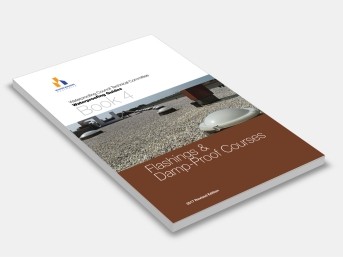Book 4 - Guide to Flashings and Damp-Proof Courses
Master Builders NSW
This Handbook has been produced as a guide to all who are involved in the planning, supervision and execution of building work. It does not set out to introduce new methods and procedures in the installation of flashings and damp-proof courses. Nothing has changed from time-honoured traditional practices. The handbook merely reinforces those practices by the efficient and improved application of them.
Flashing is a fundamental aspect of building performance. Changing construction, techniques and futuristic designs cannot take away the necessity to continue to observe the principles of effective flashing. The education and training of people in the building industry at all levels must be maintained.
This Handbook outlines good building practices for the installation of damp-proof courses, flashings and waterproofing in basic types of construction:
- Single skin masonry
- Cavity brick
- Solid masonry
- Brick-veneer
- Timber frame
- Precast walls
The handbook presents special flashing and damp-proof detailing for parapets, windows, doors, chimneys and roofs. These principles apply to all types of building construction.
The basic principle of flashing is to direct the downward flow of water to the exterior of the structure and to arrest the progress of moisture rising from the ground.
The installation of the flashing or damp-proof course must be undertaken by a skilled tradesperson who understands the principles of flashings. However, the installation should be checked and tested where necessary by the Builder and the Building Designer.
Remedial flashing requires an accurate diagnosis of the problem. Often water entry can come from more than one source. The repair method may involve a combination of different flashing details which maintain the basic principle of drainage and ventilation.
Contents:
Chapter 1: Introduction To Flashings And Damp-Proof Courses
Chapter 2: Single Masonry Walls
Chapter 3: Cavity Walls
Chapter 4: 230mm Masonry Walls
Chapter 5: Brick Veneer
Chapter 6: Timber Framed
Chapter 7: Precast Walls And Aerated Autoclave
Chapter 8: Light Weight Construction
Chapter 9: Parapet Walls
Chapter 10: Door And Window Openings
Chapter 11: Chimney vents and flues
Chapter 12: Roof Flashings
Chapter 13: Box Gutters
Chapter 14: Skylights
Chapter 15: Inspection Checklists
Chapter 16: Correct And Incorrect
Chapter 17: Glossary Of Terms
Appendix 1: Tables And Illustrations
Waterproofing Council Technical Committee
Paul Ratcliff – Chair/Building Consultant
David Viles – Graphics Content
Jack Horsfall – Retired Builder/Senior Building Inspector
Bill Straw – Consultant/Contractor
Mike Anderson – Building Consultant
Michael Parra - MBA Technical Officer
